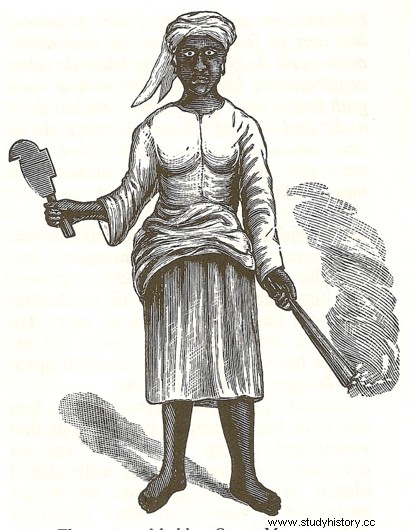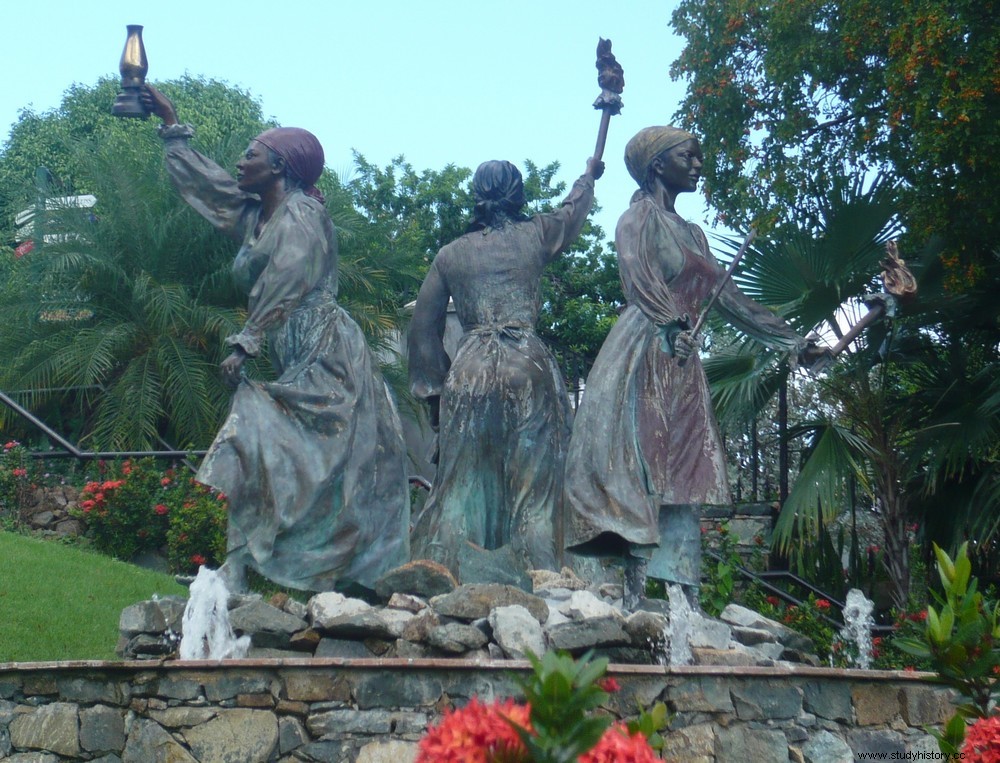Known as Queen Mary, Mary Thomas (circa 1848 – 1905) led the workers' uprising known as Fireburn, in the Danish West Indies.
Unknown past
 Little is known of the life of Mary Thomas before the 1878 uprising. Originally from Antigua, she was born in the 1840s and settled on Sainte-Croix Island, then a Danish colony, some twenty years later. Single mother of three children, she works in the sugar cane plantations of the island.
Little is known of the life of Mary Thomas before the 1878 uprising. Originally from Antigua, she was born in the 1840s and settled on Sainte-Croix Island, then a Danish colony, some twenty years later. Single mother of three children, she works in the sugar cane plantations of the island.
Prior to the uprising, Mary may have been arrested and convicted for theft, and for abusing one of her children. Accusations that could, according to historian Rikke Halberg [Danish], have been fabricated to discredit Mary thereafter. The idea that the Danish colonial authorities were interested in the way the black workers of the island take care of their children raises particular questions; on the other hand, the accusation is frequently brought against women to damage their reputation.
Work after slavery
In 1848, Denmark abolished slavery in the Danish West Islands. The following year, a law established severe working conditions in the plantations, and prohibited any negotiation to improve them. Very harsh, the contracts bind the worker and his family to a plantation and drastically restrict their freedom. Many of them then decide to leave the island to seek a better situation elsewhere.
Faced with the looming labor shortage, the colonial authorities stem the departure of workers by requiring medical certificates and imposing substantial fees on passports. If slavery is abolished, working conditions do not improve, or almost. At the beginning of October 1878, workers gathered in Frederiksted, one of the main towns of Sainte-Croix, to demand better wages and working conditions.
The Fireburn Uprising
Initially, the rally is peaceful, but the situation becomes tense when the rumor of the death of a worker at the hands of the police spreads. Stones are thrown, to which the Danish soldiers respond by opening fire, then barricading themselves in a fort. The demonstrators then turn their anger against the city and the plantations, which they loot and burn.
Mary Thomas and two other women, Axeline Elizabeth Salomon and Mathilda McBean, played prominent roles in the riots, actively participating in actions and leading rituals. The rioters make her the "queens" of the revolt, nicknamed them "Queen Mary", "Queen Agnes" and "Queen Mathilda". Particularly angry, Mary refers to herself as "captain" and calls for the beheading of those who do not wish to participate in the uprising.
The end of the revolt
Very quickly, British, French and American warships offer their help to put down the revolt, but the governor of the island refuses it. He orders the workers to return to the plantations on pain of being declared rebels, with a ban on leaving them, and calls on the army to restore order. From mid-October, calm returned to Sainte-Croix. During the uprising, more than 50 plantations were burned, 76 people died and the damage is estimated at hundreds of thousands of dollars.
Many rioters are arrested; twelve are executed quickly. Thirty-nine others, including Mary Thomas, were sentenced to death but had their sentences commuted to life imprisonment. In 1882, Mary was sent to a women's prison in Copenhagen, before being sent back to Sainte-Croix to complete her sentence.
Tributes

At Sainte-Croix, a popular song commemorates Queen Mary's participation in the Fireburn Uprising.
Queen Mary, ah where you gon’ go burn?
Queen Mary, ah where you gon’ go burn?
Don’ ask me nothin’ t’all
Just geh me de match an oil
Jailhouse basin, ah deh money dey
At Blackbeard's Castle, on the island of Saint Thomas, a statue pays homage to Queen Mary, Queen Agnes and Queen Mathilda. In 2018, a seven-meter statue of Mary Thomas, created by artists Jeannette Ehlers and La Vaughn Belle, was unveiled in Copenhagen.
